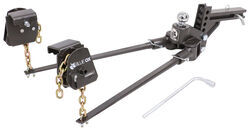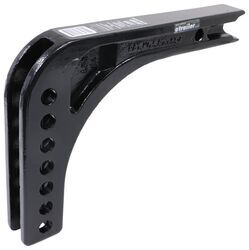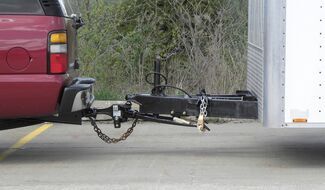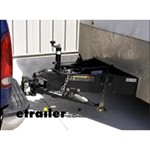
Weight Distribution for a Trailer with Varying Tongue Weight from 400 to 1,500 Pounds
Question:
I have a 2008 Suburban with Autoride and the factory installed towing package. I would like to lessen the load on that load leveling system. I pull a 7foot x 14foot cargo trailer for my business, but the weight Im pulling varies constantly, as does the distribution of it within the trailer. I will not go into why, but a certain amount of that load has to be fasten in certain areas and is not moveable. So I could go from a gross trailer weight of 2k to 6k. Im having no problem with sway unless very high wind issues, and even then I feel only a little, so Im more concern about taking weight off the tongue than anything else. I do not know the exact gross tongue weight including truck cargo, again it varies greatly, but if I were to throw numbers out, lets say from 400-1500 pounds. Again I realize not knowing my tongue weight may be a problem for you, but I can tell you without doubt it varies greatly as sometimes the load leveler on the Suburban runs for 30 seconds, sometimes for 2 minutes. One time the load lever system was not able to completely level the truck out. allow I was only using a 6inch at that time and am now more appropriately setup with an 8, so I believe that would have helped at least a little. I didnt realize at the time what I had done, but I wont do that again regardless of or weight distributing system. But just illustrating the point of variability in load. I am using the trailer every week and putting on upwards of a couple hundred miles during that week. Im looking to A understand a weight distributing system better in terms of its rating, and how much weight is transferredfoot off the truck and back to the trailer B if I go over the rating will it completely nullify its benefit, or will it only benefit you the amount that its rated for and anything over that is completely transferred to the tow vehicle C can I set-up a system to be used on heavy trips but not used on lighter trips? and if this a necessary step, is it an easy transitionfoot to unhook/remove D I frequently leave home with 6k of cargo, and off 2000 pounds of cargo at one site and travel to another the remaining 2k and then return home, what would the system require from me at each stop, if anything, to adjust for the weight loss? E How much variability is available in a system that you could recommend for my situation. F Is a weight distribution hitch a potential solution even for me?
asked by: Ross H
Expert Reply:
No worries, I can help you out with this issue. It is a common question, a varying load. There are weight distribution systems that have a tongue weight capacity range. The widest range is 600 to 1,200 pounds. There is also an 800 to 1,500 pound system. Considering that you can potentially have 1,500 pounds tongue weight you will need a system that goes at least that high.
There is a Blue Ox system, # BXW1500, that is rated for up to 1,500 pounds tongue weight and requires a minimum of 200 pounds tongue weight. So technically the system is rated for 200 to 1,500 pounds tongue weight. I believe this is going to be the best option for you. It will be more effective at the higher tongue weights and at the lower end you would experience a stiff ride. But it is better to have a system that is rated too high than one that is not rated high enough.
You will need to add a ball, # 19286. The included shank does not have a lot of drop, only 1-1/2 inches.
If I go through your questions: A) what weight distribution does is sort of push towards and up at the vehicle and trailer so the weight is more evenly distributed amongst all the axles of the tow vehicle and trailer.
B) if you go over the capacity of the system it will not be effective. If you are under the capacity, you will have a stiff ride.
C) Yes, all you really have to do is remove the spring bars. You will not have any weight distribution benefits at that point but if you are going a short distance or have a light load that day or suddenly drop a lot of tongue weight, removing the spring bars would be the way to go.
D) You should not have to do anything at each stop with this system. The head angle is fixed so that will not be a factor. If a lot of weight is suddenly removed and you are having a stiff ride, disconnecting the spring bars would take care of that.
E) The system above offers one of the widest ranges. It will not be exactly the same for all tongue weights in that range but you will get weight distribution benefits as long as you are within the range.
F) Of course! The other option is a system rated for something like 400 to 800 pounds, and then adding spring bars rated for 800 to 1500 pounds. If this is an option for you it means that you will have to change spring bars depending on the load range you are in. In this scenario you could use 400 to 800 pound system # RP66021. Then if you tipped into the 800 to 1500 pound range you would change spring bars to # RP58369 (you would need 2 of these).
Then for a shank you would use # RP63971 which is going to get you to 6-1/2 inches of drop while keeping the 1500 pound capacity. For a ball you can use # 19286. The trailer frame brackets for systems attach about 30 inches back from the center of the ball cavity on the coupler. Measure back 30 inches and that is where the center of the bracket will be. You will need 2-3/4 inches forward and rearward from this point on the trailer frame.
When using weight distribution ideally disconnecting the load leveler on the truck is the way to go. If it cannot be turned off or disconnected easily then you will first connect the trailer and let it auto level. Then when it stops you will attach the spring bars.
I have included a link to our FAQ article on weight distribution and tongue weight for you.

Products Referenced in This Question
2-5/16" Hitch Ball - 1-1/4" Diameter x 2-3/4" Long Shank - Chrome - 12,000 lbs
- Trailer Hitch Ball
- Trailer Hitch Ball
- Standard Ball
- Chrome-Plated Steel
- 2-5/16 Inch Diameter Ball
- 2-3/4 Inch Shank Length
- 1-1/4 Inch Diameter Shank
- 12000 lbs GTW
- Class IV
- Class V
- Draw-Tite
more information >
Blue Ox SwayPro Weight Distribution w/ Sway Control - Clamp On - 15,000 lbs GTW, 1,500 lbs TW
- Weight Distribution Hitch
- WD With Sway Control
- Severe Sway
- Includes Shank
- Electric Brake Compatible
- Surge Brake Compatible
- Fits 2 Inch Hitch
- Allows Backing Up
- 1100 lbs
- 1200 lbs
- 1300 lbs
- 1400 lbs
- Blue Ox
more information >
Replacement Trunnion Spring Bar for Reese Weight Distribution System - 1,500 lbs TW
- Accessories and Parts
- Weight Distribution Hitch
- Spring Bars
- 1500 lbs TW
- Trunnion Bar
- Reese
more information >
Pro Series Weight Distribution Shank - 14" Long - 4-3/4" or 6-1/2" Drop - 1.5K TW
- Accessories and Parts
- Weight Distribution Hitch
- Shanks
- Fits 2 Inch Hitch
- Round - 6 Inch Drop
- Trunnion - 4 Inch Drop
- Pro Series
more information >
Reese Weight Distribution w/out Shank - Trunnion Bar - 8,000 lbs GTW, 800 lbs TW
- Weight Distribution Hitch
- WD Only
- No Sway
- Shank Not Included
- Electric Brake Compatible
- Fits 2 Inch Hitch
- 500 lbs
- 600 lbs
- 700 lbs
- Reese
more information >













